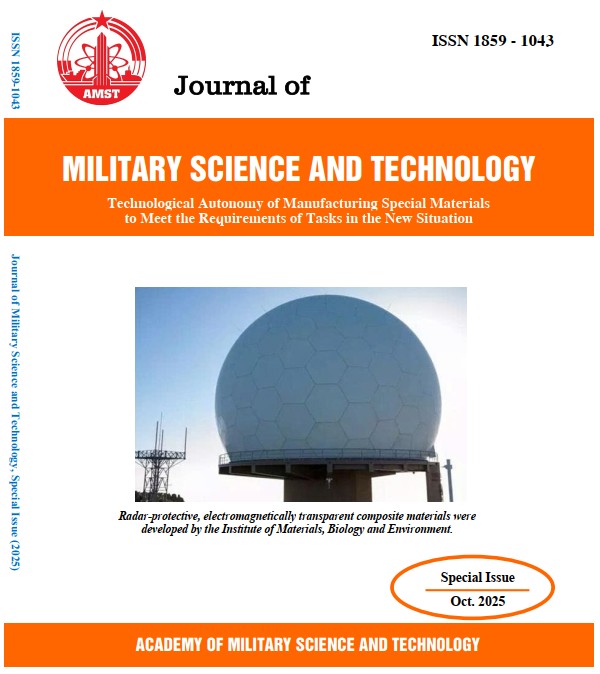Study on the effect of surface modification of aluminum powder used in epoxy coating systems for corrosion protection of steel substrates
DOI:
https://doi.org/10.54939/1859-1043.j.mst.IMBE.2025.56-62Keywords:
Epoxy coating; Aluminum pigment; APTES; KH-792; Corrosion resistance; PDP.Abstract
This study investigates the corrosion resistance of epoxy coatings containing aluminum (Al) powder surface-modified with silane coupling agents, namely 3-aminopropyltriethoxysilane (APTES), N-[3-(trimethoxysilyl)propyl]ethylenediamine, and 3-(2-aminoethylamino)propyl-dimethoxymethylsilane (KH-792). The modification process was carried out in isopropanol with sodium metasilicate to enhance the dispersion and compatibility of aluminum flakes with the waterborne epoxy matrix. The coatings were applied onto mild steel (CT3) substrates by spraying. Silane treatment improved filler distribution, increased adhesion, and reduced micro-defects, with the epoxy–Al–APTES system showing the best protective performance, as indicated by a positive shift of the corrosion potential (Ecorr) and a significant decrease in corrosion current density (icorr). The protection mechanism was attributed to the combination of physical barrier effects, sacrificial anodic protection of aluminum, and enhanced cross-linking through chemical interactions between silane and epoxy. The modified aluminum powders were characterized using SEM, EDX, FTIR, and XRD, while the corrosion resistance was evaluated by potentiodynamic polarization (PD) and electrochemical impedance spectroscopy (EIS) in 3.5 wt.% NaCl solution.
References
[1]. Chopra et al., "Recent advances in epoxy coatings for corrosion protection of steel: Experimental and modelling approach—A review," Materials Today: Proceedings, 62, pp. 1658–1663, (2022).
[2]. J.-h. Liu et al., "Corrosion resistance of waterborne epoxy coating pigmented by nano-sized aluminium powder on steel," Journal of Central South University, 19(1), pp. 46–54, (2012).
[3]. M. Q. Zhang et al., "Improvement of tribological performance of epoxy by the addition of irradiation grafted nano-inorganic particles," Macromolecular Materials and Engineering, 287(2), pp. 111–115, (2002).
[4]. M. Toozandehjani et al., "Aluminum composite powder as an additive in epoxy coatings for enhancement of corrosion protection of carbon steel," Journal of Central South University, 31(3), pp. 723–736, (2024).
[5]. U. Abdus Samad et al., "Corrosion resistance performance of epoxy coatings incorporated with unmilled micro aluminium pigments," Crystals, 13(4), p. 558, (2023).
[6]. H. J. Kim et al., "Enhancement of mechanical properties of aluminium/epoxy composites with silane functionalization of aluminium powder," Composites Part B: Engineering, 43(4), pp. 1743–1748, (2012).
[7]. B. Salgin et al., "Role of surface oxide properties on the aluminum/epoxy interfacial bonding," The Journal of Physical Chemistry C, 117(9), pp. 4480–4487, (2013).
[8]. D. Saber et al., "Enhancement of barrier and mechanical performance of steel coated with epoxy filled with micron and nano alumina fillers," Materials Research, 25, p. e20210413, (2021).
[9]. J.-q. Huang et al., "Incorporation of Al₂O₃, GO, and Al₂O₃@GO nanoparticles into water-borne epoxy coatings: abrasion and corrosion resistance," RSC Advances, 12(38), pp. 24804–24820, (2022).
[10]. S. Feliu Jr., "Electrochemical impedance spectroscopy for the measurement of the corrosion rate of magnesium alloys: Brief review and challenges," Metals, 10(6), p. 775, (2020).







